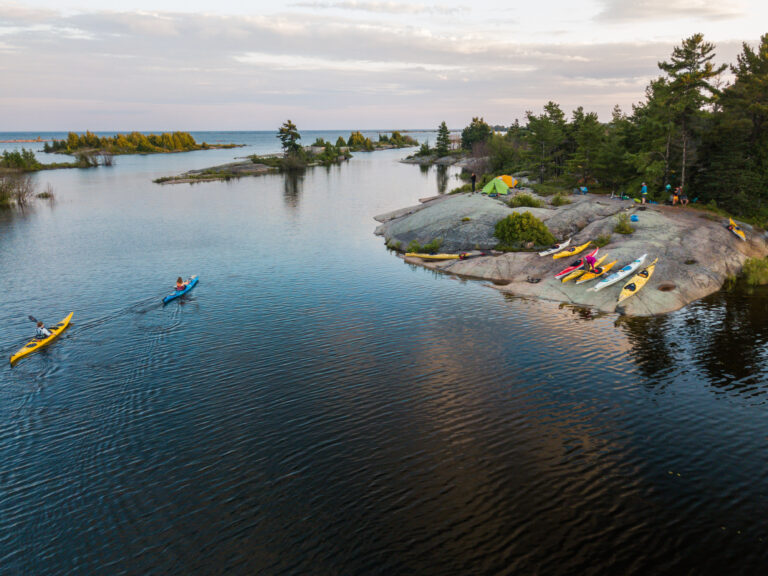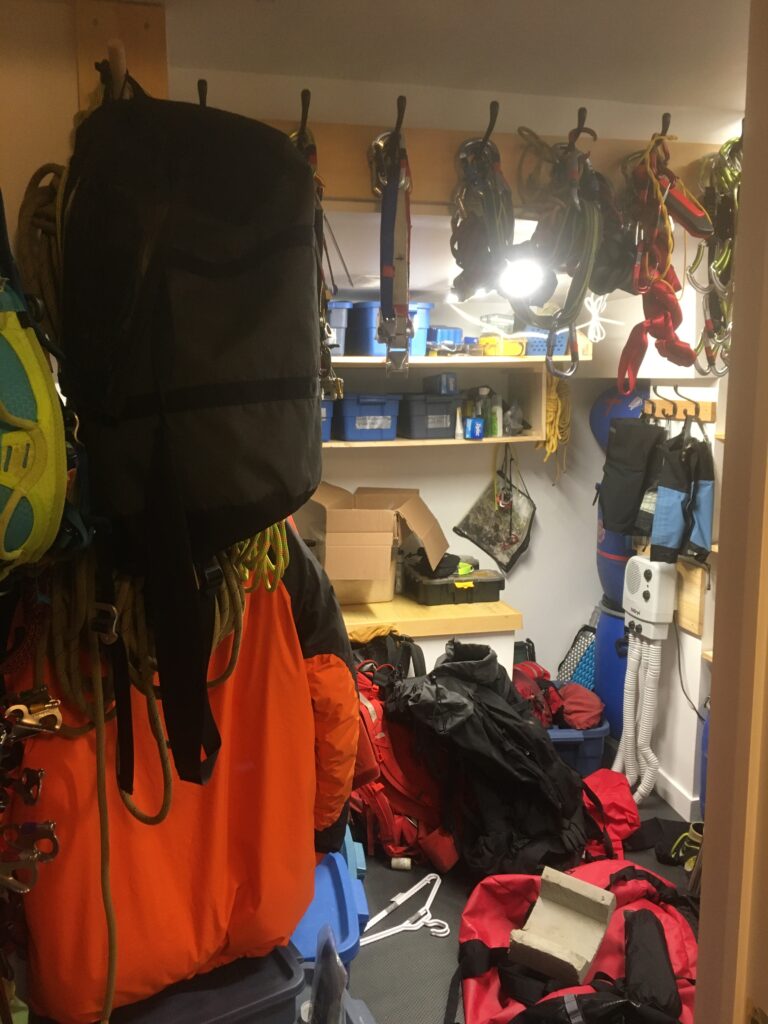It is difficult to describe the feeling of being in the Arctic. Travelling far above the treeline, the landscapes are so vast you feel as though there are no people left on the earth but you and your companions. The world opens before you, stretching as far as the eye can see from horizon to horizon, and gives the impression of being able to reach a mountain over 50 km away in a single day. The silence is at once deafening, and yet profoundly peaceful, somehow demanding respect from all who travel through. For most, if not all of the year, ice reigns supreme, whether capping distant mountains or creeping slowly into the sea.
 The flowers that sprout there are the hardiest you will ever encounter – survivors – most spanning no more than a few millimetres across. With such a short season of warmth and daylight, it can be easy to forget that the Arctic is one of the most productive ecosystems in the world, with a diverse population of fish and migratory birds that make the journey there each summer to breed. These seasonal travellers find a balance with the more permanent residents, such as Walrus, Muskox, Fox, Caribou and Polar Bear. Humans too have called it home for thousands of years, their traditional practices honed over centuries to co-exist and thrive in one of the last truly wild places on earth.
The flowers that sprout there are the hardiest you will ever encounter – survivors – most spanning no more than a few millimetres across. With such a short season of warmth and daylight, it can be easy to forget that the Arctic is one of the most productive ecosystems in the world, with a diverse population of fish and migratory birds that make the journey there each summer to breed. These seasonal travellers find a balance with the more permanent residents, such as Walrus, Muskox, Fox, Caribou and Polar Bear. Humans too have called it home for thousands of years, their traditional practices honed over centuries to co-exist and thrive in one of the last truly wild places on earth.
It is a place of extremes; from endless days to endless nights, infinite oceans to blinding ice. It is a place where we feel both insignificant, yet so impactful with every step taken. And it is a place that, when visited, can never be forgotten.
Read on to learn more about two spectacular trips through this incredible landscape, by water and by land.
THOMSEN RIVER
If you’re looking to paddle a northern river, you can’t go further than the Thomsen. The northernmost navigable river in the world, it gently cuts its way across Banks Island in Canada’s Arctic Archipelago, making its way to Castel Bay. Along its route, it passes through Aulavik National Park, which on average sees less than 20 visitors each year. This is a true wilderness river, and one that not many people in the world can say that they’ve seen, much less explored.

The gentle current of the water, coupled with a few swifts, makes for some very relaxed paddling and gives plenty of time to take in the incredible landscape, as well as search for some of the local residents. And this, above all, is perhaps where the Thomsen River most shines.
Banks Island itself is a haven for wildlife. Boasting the world’s largest population of Muskox, it is also home to both Peary and Barren-ground Caribou, Arctic Hare, Foxes and Wolves, and of course the occasional Polar Bear nearer to the ocean shores. Drifting down the river, it is not uncommon to hear the mating calls of the migratory birds that flock to the island in the warmer season, along with the resident Snowy Owls and Snow Geese, nesting between the orange speckled rocks of the tundra. The feeding and mating season is short here, and for a few brief moments each year the island explodes with life. During these summertime months the treeless landscape also teems with wildflowers, painting the otherwise dry, brown earth in a rainbow of colours.

Looking amidst this beautiful riot, it can be easy to miss the other signs of life here in the Arctic.

An occasional circle or stack of rocks that looks just shy of natural, or perhaps the occasional forgotten bone tool serve as the only reminders of a peoples who once occupied this vast landscape. The Dorset and Pre-Dorset cultures, dating back to 3200 BC were some of the earliestknown settlers of the Arctic, and relied heavily on hunting sea mammals, such as walrus and seal, and travelling with the seasons. Now long extinct, it is surreal to stand by one of those tent rings today, half sunken into the earth, and realize that you are looking at something thousands of years old, from a culture that no longer exists. But time moves slowly in the Arctic, and the land there remembers.
As you travel downstream, opportunities for exploration are endless, as treeless rolling hills provide unimpeded hiking in any direction. Although never guaranteed, bird and wildlife sightings are quite common, and we would recommend bringing the good camera…it’ll be worth its weight in photographs.

As a wilderness, wildlife, and cultural destination, the Thomsen is the perfect choice for anybody, whether you are seeing the Arctic for the first time or are a seasoned explorer. For more information or to book a trip, you can click here.
QUTTINIRPAAQ NATIONAL PARK – BASECAMP OPTION
It is sometimes known as Umingmak Nuna – “Musk-Ox Land”. It is the world as it was at the end of the last ice age. The remnants of the ice sheets that once covered north America live on here, seemingly brooding over their lost dominion.



From the remaining ice caps and glaciers, water rushes down through the mountain valleys, feeding continually shifting rivers that scour the land, moving and grinding rock that will eventually find the arctic sea.
Yet, it is not barren. The tenacity of life is on full display. Flowers bloom in the short season available. Covers of Avens break up the hard cracked ground and in the disturbed gravel beds of the rivers, the large violet petals of River Beauty can be found.
These relatively vibrant valleys form what is known as “The Musk-Ox Way”. A line of life across the far north believed to be the migration route of large mammals and the original Thule Peoples that followed them from the Alaskan Coasts to Greenland a millennia ago. The ancestors of the modern Inuit.
Canada’s most northerly park, Quttinirpaaq (Top of the World) is located along this route. Tanquary Fiord, a repurposed Defense Research Board Base from the Cold War, will be our base of operations. From here we will embark on multiple day trips (Basecamp Option) or a 130 km trek linking valleys together to circumnavigate the Ad Astra and Viking Ice Caps (Ad Astra Trek).

The Base Camp at Tanquary Fiord features a Quonset Hut Kitchen and meeting area, outhouse, small outdoor solar shower (for warm days!) and a spectacular view of the Fiord itself reflecting the surrounding mountains and glaciers. The mountains and valleys nearby provide multiple day-hiking opportunities to explore the landscape, view wildlife or observe the artifacts of past human activity.

From camp there are mountains all around. Some tall and jagged, some appearing painted, and some sloped and inviting a hike. There are small hidden valleys to be found, as well as clear creeks, red streams, and silted rivers to be followed. However, in the first days it is the utter scale of the landscape that tends to dominate perceptions. It is not easily described but is overwhelmingly felt. It is geography writ large, forcing a reconsideration of the significance of a single consciousness inching forward to explore.
The Umingmak (Inuktitut for “The Bearded Ones”), Muskox, are still here of course, and often spotted in and around the area of the Base Camp at Tanquary Fiord. Wolves and arctic fox also occasionally haunt the area led by curiosity or seeking prey. Birds abound as well. Their calls punctuate the occasional quiet moment when the wind relents in this treeless landscape. Plovers, Turnstones and Longtail Ducks flock near the small pools and ponds in and around camp while just outside of camp on the alluvial flats Red Knots nest, Jaegers hunt and Eiders corral their young.
 Despite its seeming isolation and remote location, the area of Tanquary Camp has seen a variety of human activities over the years. History is real here. It can be seen and touched. It hasn’t been removed to a museum to the south. The artifacts of the past rest where their owners left them in the north. Whether Thule era fox traps and food caches of stone, or the vehicles of cold-war era defense researchers, they can be found within or near to the camp.
Despite its seeming isolation and remote location, the area of Tanquary Camp has seen a variety of human activities over the years. History is real here. It can be seen and touched. It hasn’t been removed to a museum to the south. The artifacts of the past rest where their owners left them in the north. Whether Thule era fox traps and food caches of stone, or the vehicles of cold-war era defense researchers, they can be found within or near to the camp.
Umingmak Nuna. Quttinirpaaq. It is a place of extremes – from endless days to endless nights, infinite oceans to blinding ice. It is a place where we feel both insignificant, yet so impactful with every step taken. And it is a place that, when visited, can never be forgotten.
For more information or to book a trip to Quttinirpaaq, click here.
Written by Black Feather Packing Center Manager Dana Sykora and Hiking Program Supervisor Mike Hill

